This is a soft but rustic bread dough filled with good-for-you oats and whole wheat flour. It can be made into dinner rolls, burger buns, and sandwich bread, with substitutions for when you don't have enough of one of the flours. And it freezes wonderfully, so you can bake a large batch and have warm rolls and toast every day!
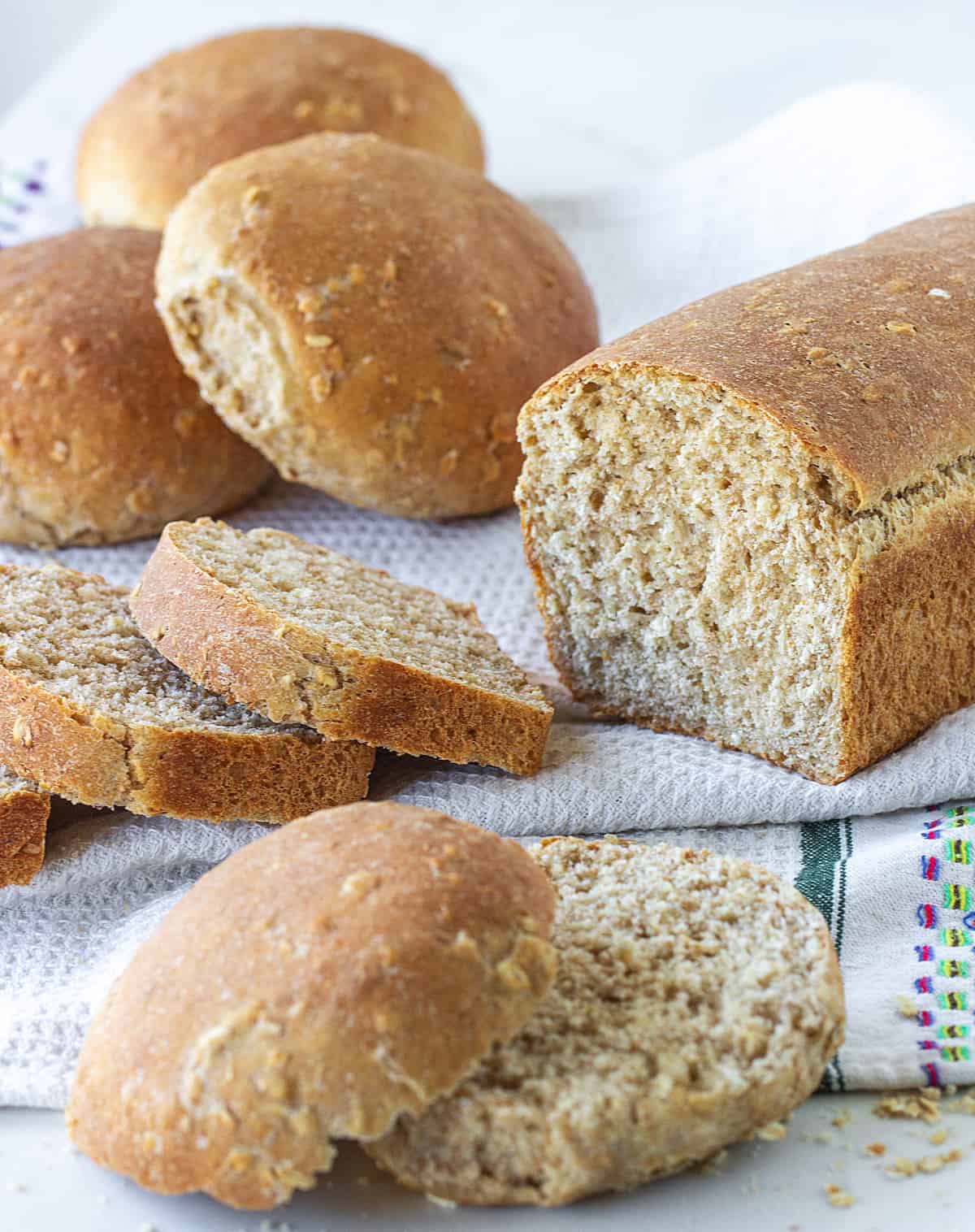
A hearty bread dough for multiple uses
This recipe can become a favorite if you like making bread with some texture in it. I used to make only dinner rolls with this recipe. Maybe a loaf, but mostly cute little breads for soups or sliders.
It turned out that it's very adaptable to different flour mixes, add-ons and shapes.
So, I'm republishing it with new photos, tips for making buns and loaves, and a way to make it with different amounts of flour—just in case you don't have enough of one but have another.
These past few months found me making a lot of homemade bread (the best therapy!) and freezing most of it, from all whole wheat bread to the easiest baguette recipe. I also posted a simple guide to Freezer Baking & Desserts, in case you're interested.
- It has a faint hint of sweetness from the honey and a little coarseness from the whole wheat and oat flour.
- It's a straight dough and fairly simple to make, but it gives you a lot of control over crust and crumb.
- Make it more or less rustic by using different amounts of the different flours.
- Make one recipe and form different shapes so you have a bit of everything, from toast to healthier burger buns.
Any way you look at it, this bread is an absolute winner year-round. I think you should give it a try asap.
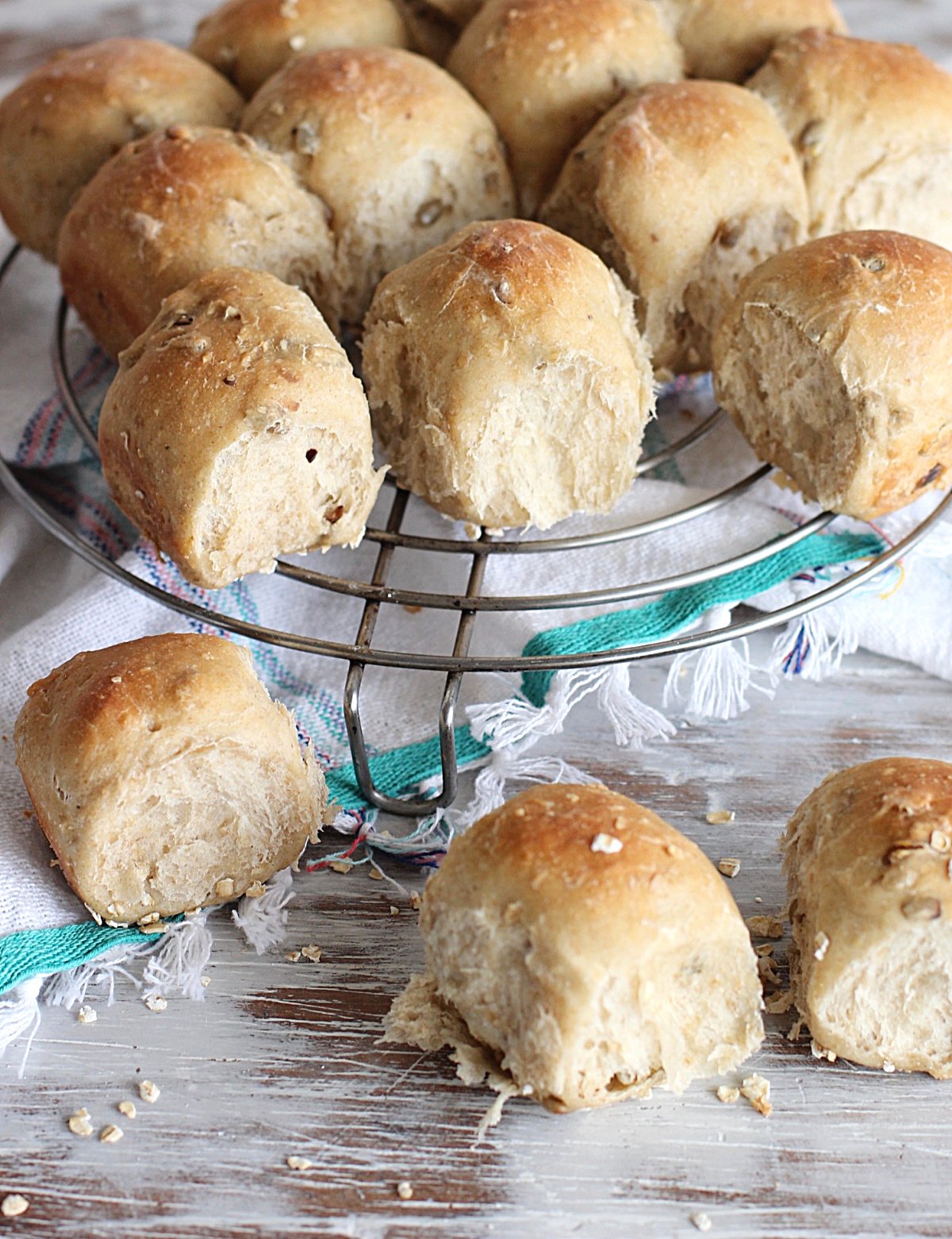
Ingredient list
- Bread or all-purpose flour: I use bread flour (it has a higher gluten content) but all-purpose work well too.
- Whole wheat flour: I recommend superfine which is pretty similar to white flour in how finely ground it is. It will make the bread softer while still keeping all the qualities.
- Oats: I use old-fashioned rolled oats (traditional oats) because they have more texture, but you can use instant or quick-cooking oats.
- Types of yeast: besides active-dry yeast, you can use instant yeast (¾ of the amount given for active dry) and add it to the flour, then add the water. Or fresh yeast (3 teaspoons) that you crumble and mix with the water first.
- Oil: I like olive oil but you can use any type you want. They all work fine.
- Salt.
- Milk: I always use whole milk because of its richness, but reduced in fat, lactose-free, and almond milk also work.
- Egg: fresh, large.
- Runny honey.
Quantities are listed on the recipe card towards the end of this post. The Ingredients page has more details and lists the brands we use.
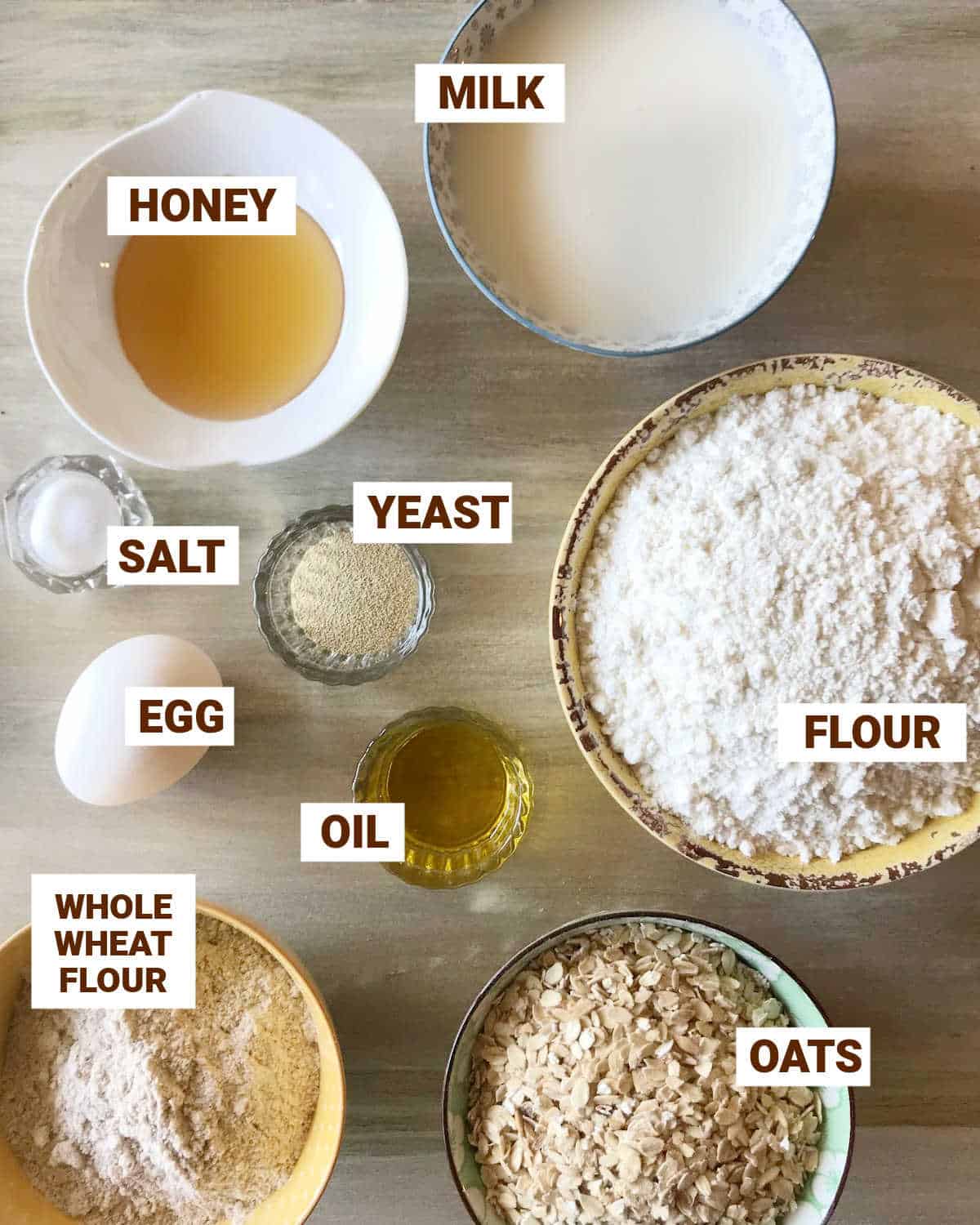
Kneading
Stand mixer: it's an easy way of kneading this bread, and I recommend it if you have one. Use it with the dough hook.
By hand: it is doable and a great way to get to know the dough and how it should feel to the touch. I started baking bread this way and recommend it if you have some arm muscle to spare.
It's important to know when to stop adding flour. Eventually, the bread comes together without sticking like crazy to the edges and bottom of the bowl.
Though recipes come with an amount, yeast bread is very temperamental and can suffer changes, for example with how humid the place is. That's why most yeast bread recipes come with a variable amount of flour.
Vintage Kitchen Tip
After adding flour always allow some time, about 30 seconds, for it to be absorbed before deciding if you need to add more.
Shaping the dough
You can make dinner rolls, sandwich loaves or burger buns with this recipe.
Dinner rolls:
- I like using more white flour when making these so that they are softer. Especially for sliders or small sandwiches.
- I make them about 1 ounce each. The whole recipe yields 30-32 rolls and I use two 9x13-inch pans.
- Place them barely touching in the pan and let them proof (rise) until they look like they're snuggling (image above).
- Here is a quick tutorial: How to shape dinner rolls that might come handy.
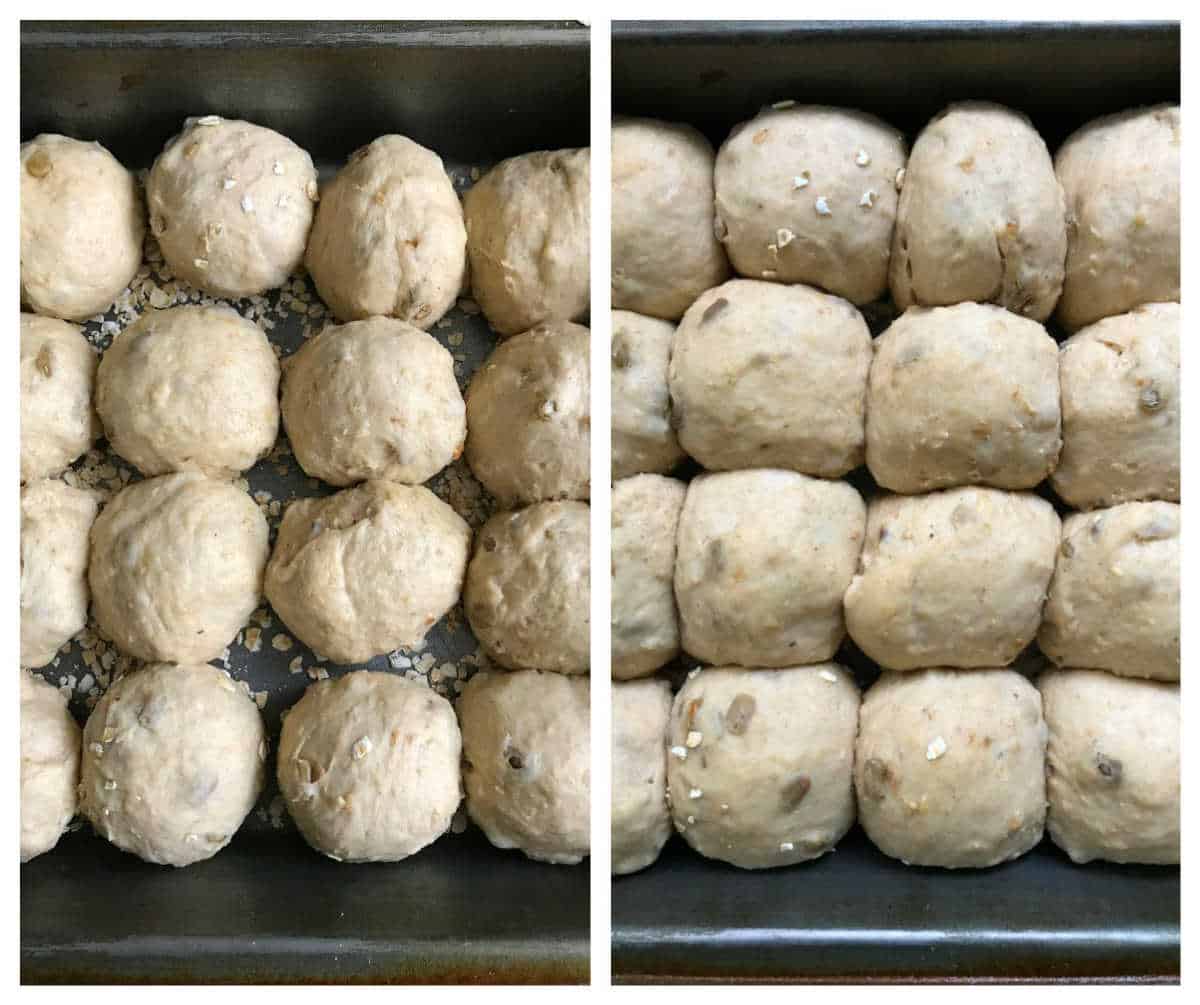
Hamburger buns:
- Similar to the small rolls above, they need a little more space so that they bake thinner and don't rise as much (image below). That is what we want in a burger bun so that it baked with less crumb.
- This recipe yields about 12 buns. I use two 9x13-inch pans.
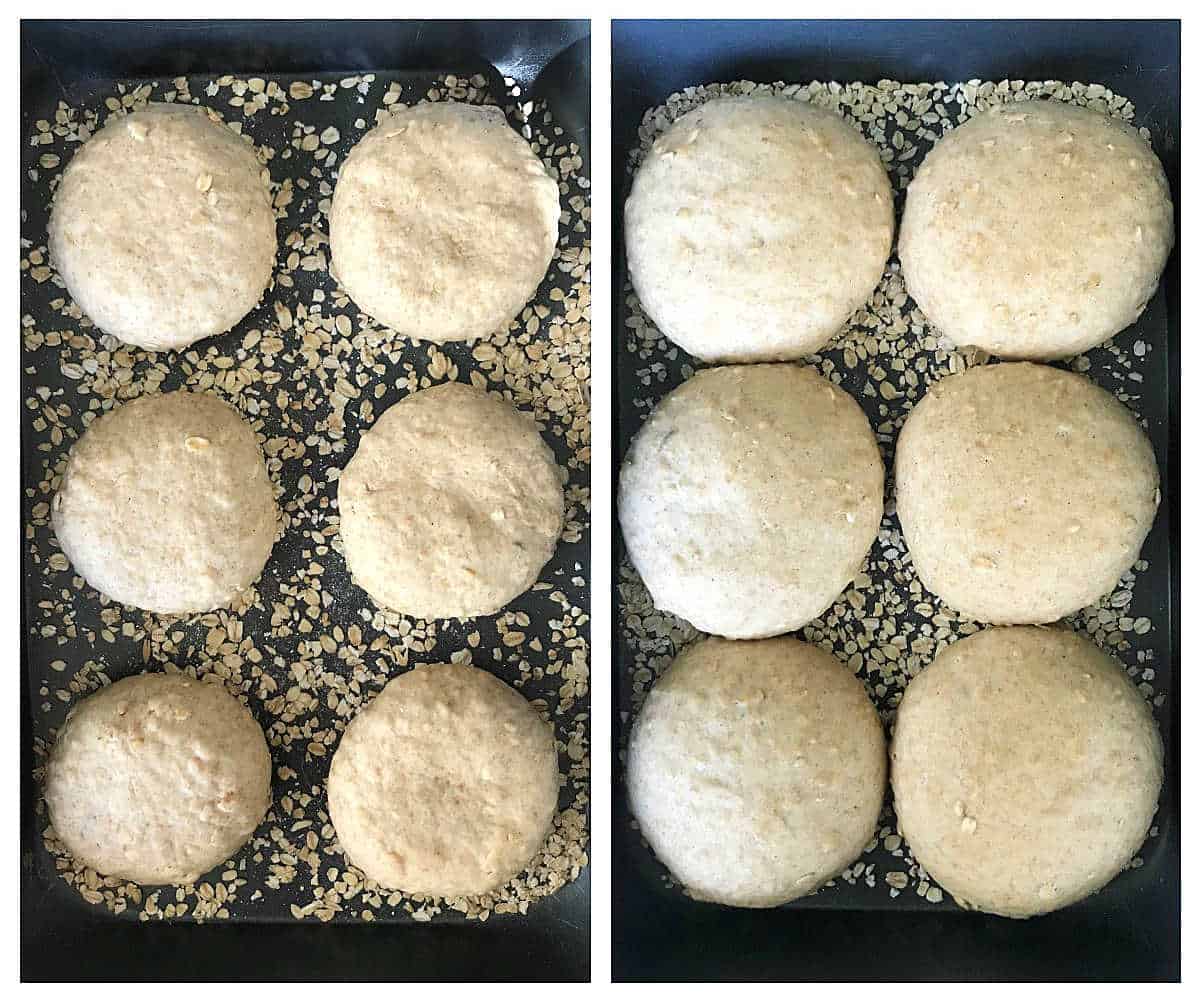
Loaf bread:
- This recipe yields two 4x9-inch loaf pans.
- How to form the sandwich loaf: make a rectangle with the dough after it rises the first time. Roll it away from (as you would cinnamon rolls) and seal each turn with your palm (images 1 and 2) or with your fingers.
- Put into the pan and lightly flatten the dough with your palm so that it reaches the angles and the whole thing is covered (image 3). It might shrink back a little, that is fine. We do this so that the loaf bakes as evenly as we want. Let rise before baking (image 4).
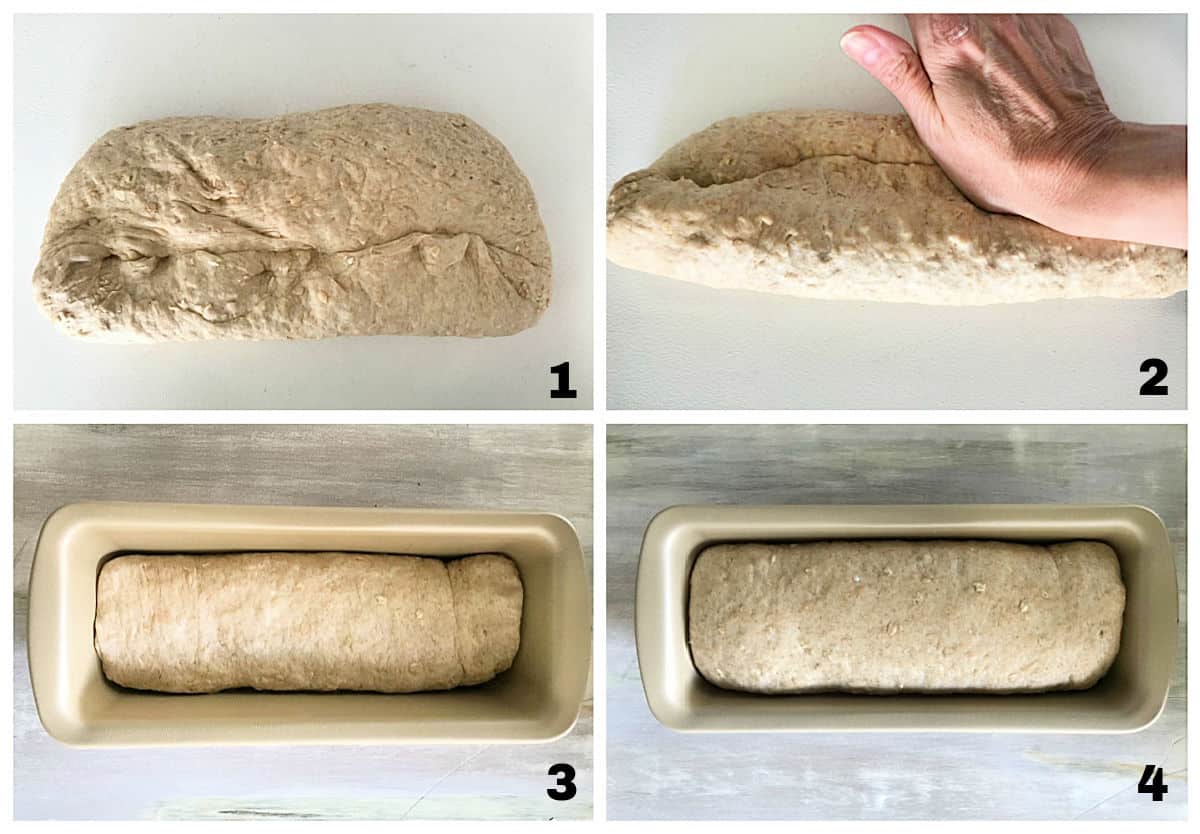
Variations
- Flours: make them softer by using more white flour and coarser by using more whole wheat flour.
- Additions: add 2-3 tablespoons of seeds (sunflower work great and I use them for the dinner rolls) or chopped walnuts which pair great with oatmeal and whole wheat.
- Finishing: you can glaze before baking with an egg wash (lightly beaten egg with 1 tablespoon water or milk) and top with seeds. It will have a shinier finish. Or just a brush of water and the seeds.
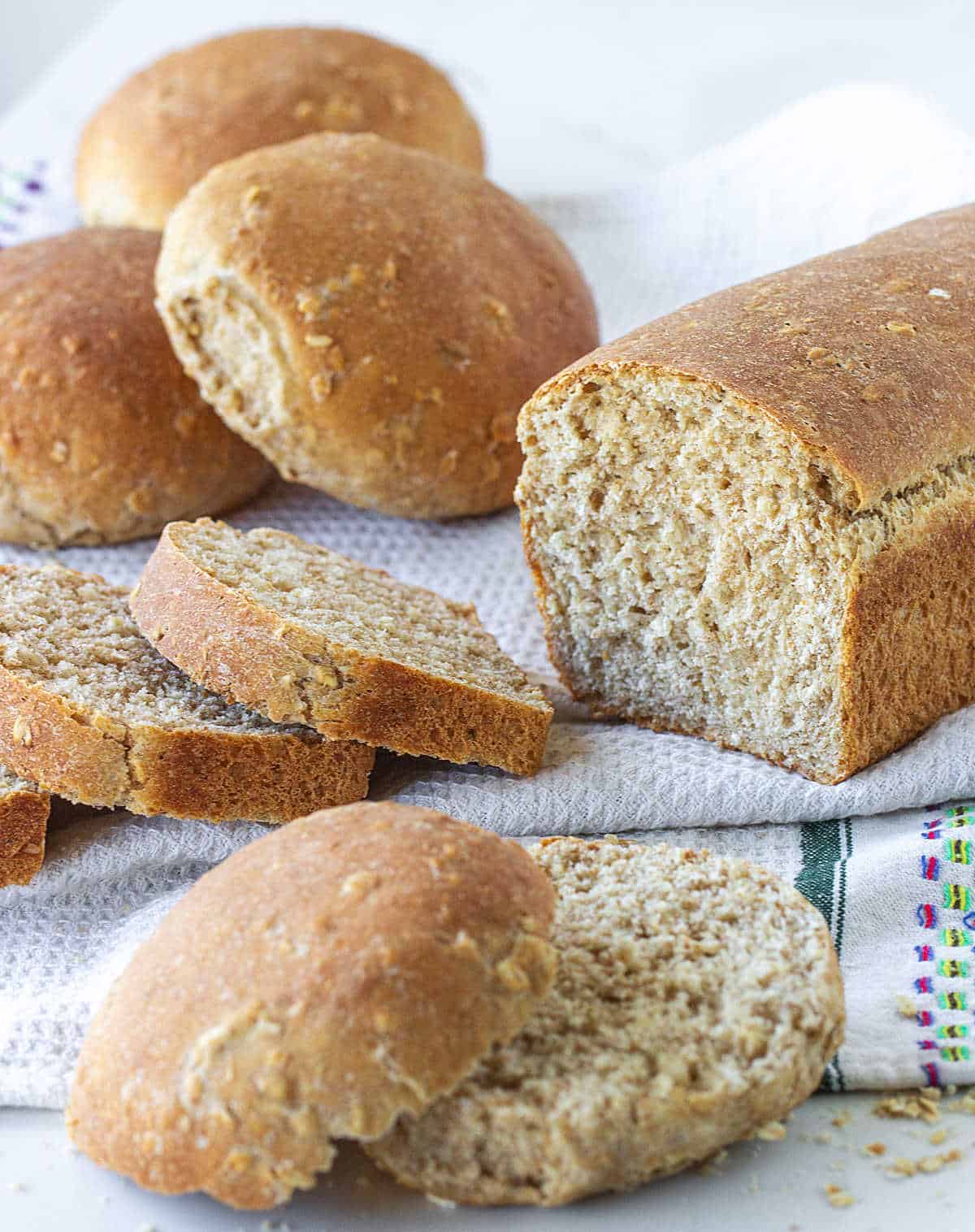
Storing
It keeps well for a day and can be refrigerated, well-wrapped, after that. It's best to warm slightly before eating.
I suggest freezing any bread you will not consume in a few days or up to a week. Make a large batch and freeze it after it's baked.
- Rolls and buns: let cool and freeze. Sometimes, I freeze them while still slightly warm as they seem to retain moisture better.
- Loaf: I recommend you slice it first. It's easier to defrost or pop into the toaster directly. You can freeze it whole of course, but it will take a while to defrost.
Related recipes you might like:
Before you go
If you made this recipe and loved it, you can comment below and leave a five-star ⭐️ review. Also, if you had issues, let me know so we can troubleshoot together.
You can also subscribe to our FREE email series 'Baking the Best' and our regular newsletter. Or follow and save my recipes on Pinterest.
As an Amazon Associate, I earn from qualifying purchases. Read my disclosure policy.
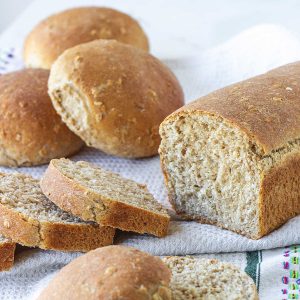
Whole Wheat Oatmeal Bread
Ingredients
- See Notes, below, for using different amounts of flour to get softer or coarser bread.
- 1 cup superfine or fine whole wheat flour
- 1 cup traditional oats
- 1 tablespoon active dry yeast, if using fresh yeast, use 3 times the amount
- 1 cup warm milk, not hot
- 1 ½ cups warm water
- ¼ cup of runny honey
- 1 egg, at room temperature
- 2 tablespoons oil, like sunflower, olive or canola
- 1 tablespoon salt
- 4 ½ to 5 cups bread flour or all-purpose flour
Instructions
- In a large bowl (I use my Kitchen Aid), stir 1 cup whole wheat flour, 1 cup oats and1 tablespoon active dry yeast.
- Add 1 cup milk, 1 and ½ cups water, ¼ cup honey, 1 egg, 2 tablespoons oil and mix well with a wooden spoon or round spatula.
- Using the dough hook, start kneading at medium speed, adding 1 tablespoon salt and 4 to 5 cups bread flour, half cup at a time. You can also knead by hand, adding all you can in a large mixing bowl and finishing it on a lightly floured counter.
- Using a stand mixer should take 6 or 7 minutes; around 10 if kneading by hand. The dough is barely sticky and should eventually leave the sides of the mixer bowl or the counter if kneading by hand.
- Always add ½ cup at a time and wait about 30 seconds until the flour is absorbed before adding more. You don’t want a very firm dough; it should be slightly sticky.
- Oil a large bowl that can handle the dough doubling its volume, and place in the dough, turning it around to oil it completely.
- First rise: cover with film and let double in volume. It will take 1 and ½ to 2 hours in a warm place. I sometimes wrap it in a sweater or blanket if the room is a little cold.
- Lightly punch the dough with your fist and transfer it to a clean counter. Carefully flatten it a bit and divide it in two pieces.
- For dinner rolls: divide the dough into about 30 pieces. Make each into small balls pinching the dough at the bottom. Cover each ball with the palm of your hand and make circular movements to smooth and round the pieces. Repeat with all balls.
- For burger buns: divide the dough into 12 pieces. Repeat the process for the dinner rolls above, but flatten the balls after forming them so they bake with less inside crumb.
- For a sandwich loaf: make a rectangle, long side parallel to the edge) and roll away from you (as you would cinnamon rolls), pinching the dough together with each roll until you have a loaf.
- For all shapes: dust the pans with some oatmeal or polenta in the bottom and place the rolls or buns, or loaves. See the Notes below for finishing specifications.
- Second rise: cover pans with clean kitchen towels and let rise until puffed, about 1 hour.
- Meanwhile, preheat the oven to 350ºF (180ºC).
- If you want, brush the top of the rolls with a little water and sprinkle oats on top. Or use an egg wash, see Notes below.
- Bake for 30 to 40 minutes for loaves, about 20 minutes for rolls, and about 25 minutes for buns, or until golden on top and the bottoms sound hollow when lightly tapped.
- Remove from pans and let cool completely on a wire rack. They are best eaten the day they are made, and can be frozen.
Notes
Adapted from Bread, by Beth Hensperger

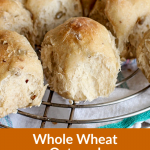
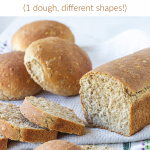
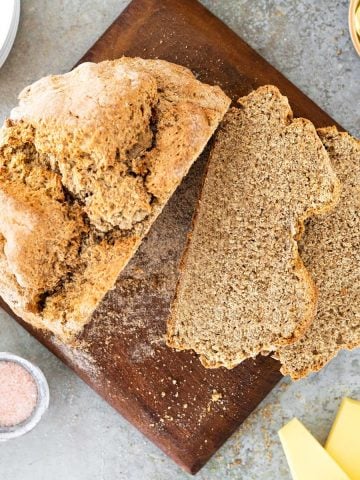
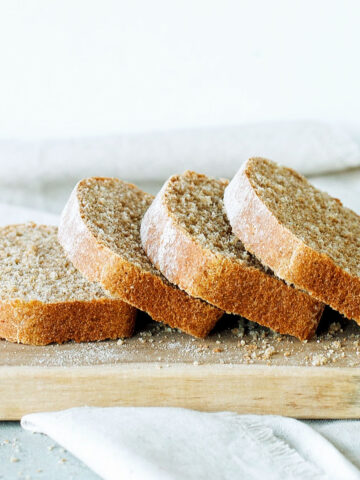
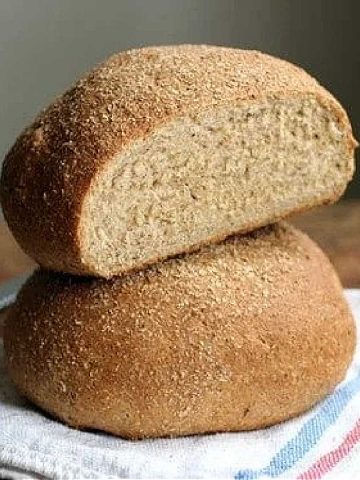
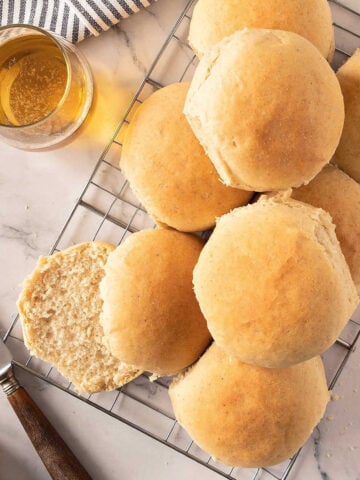
Kathleen H. says
This looks like a great recipe and I must try. The only downside for me with fresh bread is the fact that it doesn't stay fresh over a day and then you can only use it toasted (and if you freeze you can only use it toasted anyway). But I love bread and need to make it more often so I can get better at it
Caro Jean says
Trying your bread recipe now. Baking 1 loaf of bread and some yeast rolls.
Elisheba says
Thanks for this recipe. It's great. We made burger buns last nite n they were biiiiig. Only thing we noted was that the dough was very sticky and cooking time and temp were a bit low so we ended up cooking the buns for about 40 minutes. They r delicious we will certainly be making more of these.
Elisheba says
We made dinner rolls and "French bread" this time round and the results were amazing. Thanks Paula
Ann says
I love the bread but don't see where to add the egg in the instructions. I put it in with the liquid.
Paula Montenegro says
Hi Ann! Yes, the egg goes in with the liquid or wet ingredients. How did it turn out?
Sudha Gurtoo says
Tried this bread and we loved it. Thank you for sharing.
Paula Montenegro says
So happy you did Sudha!
Lina says
Hi Paula I look forward to making this bread. I am finding it hard to find whole wheat flour, seems the shelves at our stores have not stocked it for some time. And also can I use my bread maker to make this recipe as a loaf bread.
Paula Montenegro says
Hi Lina, you can use the bread maker, just make sure the amount of ingredients is according to the bread machine's capacity instructions. Spelt flour should work also, though I haven't tried it; maybe it's easier to find since it's not as common as whole wheat.
You can use all white flour; it will be a different bread. You can also use some fine rye flour (if you like the flavor), maybe a cup, together with white flour if you can't find whole wheat. Hope this helps!
Aline says
Homemade dinner rolls are the best!! I can't wait to get my hands on some yeast so I can try to make these! Look so delicious!
Kelly Anthony says
I love your idea of baking bread right now since we have so much time on our hands to freeze for later use.
Eva says
I've also been bread baking like crazy these days, so I love every bread inspiration post I come across. Thank you for this, I need to add oats to my next baking adventure!
megan says
Yumm this recipe sounds delicious and your tips will be super helpful!
Colleen says
I've been looking for a bread recipe that has oats and this one looks perfect. I love all the tips too. Can't wait to try this.
Angie@Angie's Recipes says
Soft, tender and healthy...now all I need just a bowl of steaming hot soup for a comforting lunch!
Paula Montenegro says
I agree Angie, have a great week!